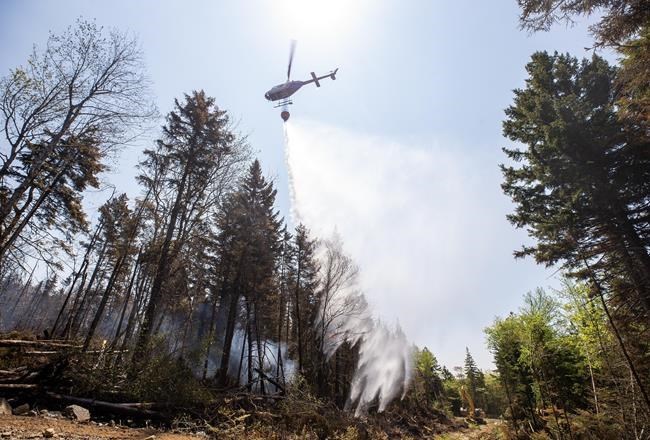HALIFAX — Scores of Halifax-area residents whose homes were destroyed by wildfires boarded buses Friday to get a look at what little remains of where they used to live.
Katherine Tarateski, a local real estate agent who lost her home during the fire, said she had already seen images of her house in ruins. But she said she wanted to help a neighbour who would be seeing the remains of her home for the first time.
“I’m going to support my friend because she was living alone, and she doesn’t want to be alone when she sees what's left there,” Tarateski said. “It’s very emotional."
Before three transit buses left a parking lot in Upper Tantallon, N.S., Red Cross workers hovered nearby, providing bottles of water and hugs to some of the passengers.
Local resident Jody Stuart, who also lost his home to the fire, said he didn't want to be a part of the grim tour.
"I need to physically go and do my thing with family and friends beside me," said Stuart, whose nine-year-old daughter was sitting behind him in his pickup truck, cuddling a stuffed dog.
"I’ve done a lot of hugging and crying," Stuart said. "(But) I don’t plan on leaving my community, as I love my community."
The contractor said his home in the Yankeetown subdivision contained all of his tools, which are now gone. "There are just two houses still standing (on my street)," he said. "It’s unbelievable.”
Bill Moore, the municipality's executive director of community safety, told a news conference Friday that more than 200 people were expected to take part in similar tours in the coming days.
The wildfire that broke out Sunday in Upper Tantallon raced through a number of subdivisions and consumed about 200 structures, including 151 homes. In all, more than 16,000 people were evacuated from homes and businesses northwest of the port city's downtown, but one of the orders was partially lifted Friday.
“We’re very sensitive to the trauma this may cause people,” Moore said of the visits to the burnt zone, adding that the first people admitted into the evacuation zone would be those whose homes were destroyed by the flames. Next, residents whose properties suffered less damage will be invited into the area.
The Tantallon wildfire was among four wildfires in Nova Scotia still considered out of control on Friday. But 50 per cent of the Halifax fire was contained by firefighters.
Dave Steeves, a forest technician with the Department of Natural Resources, said firefighters at the Halifax fire faced hot, dry conditions almost all week, but they kept working "like a well-oiled machine."
Nova Scotia Premier Tim Houston said there was plenty of work to be done but it was clear he was feeling a bit relieved on Friday.
“Through all of this despair, zero deaths, zero missing persons, zero serious injuries,” he said during a video conference as he stood in front of a fire truck. “This says a lot about the professionalism of the first responders that are leading the response."
In Halifax, deputy fire Chief Roy Hollett said Friday that some of the damaged and destroyed homes were still burning, and he stressed that some of the affected neighbourhoods are still part of an active fire scene. That's why those travelling through the area as part of the bus tour were not allowed to leave the vehicles.
"I was out there last night," Hollett said. "The smoke was very thick. You could taste it."
Meanwhile, the forecast was calling for steady rain Friday night and into Saturday.
"We're getting rain, and lots of it," Bob Robichaud, a senior meteorologist with Environment Canada, told an afternoon briefing. He said the heaviest rain, which will extend into next week, will fall on the western side of the province, where it is needed most.
Halifax Mayor Mike Savage said that's what he has been praying for. "If you happen to know the Almighty, talk to her," Savage told a briefing. "Put in a good word for us."
In the southwestern corner of the province, a much larger wildfire continued to burn out of control in Shelburne County, where 6,700 people have been evacuated from their homes — about half of the municipality's population.
The Barrington Lake wildfire, which started Saturday, continued to grow on Thursday, reaching more than 200 square kilometres — the largest recorded wildfire in the province's history. It has consumed at least 50 homes and cottages.
“We’re experiencing a fire like we’ve never experienced before,” Eddie Nickerson, warden of the Municipality of Barrington, said Friday.
On Thursday, a small fleet of water bombers took aim at the big fire amid soaring temperatures and extremely dry conditions. They also tried to douse a fire that started Wednesday very close to the town of Shelburne, which prompted another series of evacuations in the county.
Dave Rockwood, a spokesman for the Department of Natural Resources, said the biggest fire was fed by strong winds on Friday and it wasn't letting up. “This thing has some teeth," he told a news conference via video link, adding that the fire was rolling "like a freight train.”
"When these fires get this big, it's very hard to stop them," he said. "Forty water bombers, they're not even going to make a difference."
Rockwood said Nova Scotia has been drier than usual for the past five years.
“It’s created a perfect storm. You cannot stop these (fire) machines no matter what you have to throw at it."
This report by The Canadian Press was first published June 2, 2023.
— With files from Keith Doucette
Micheal Tutton and Michael MacDonald, The Canadian Press



